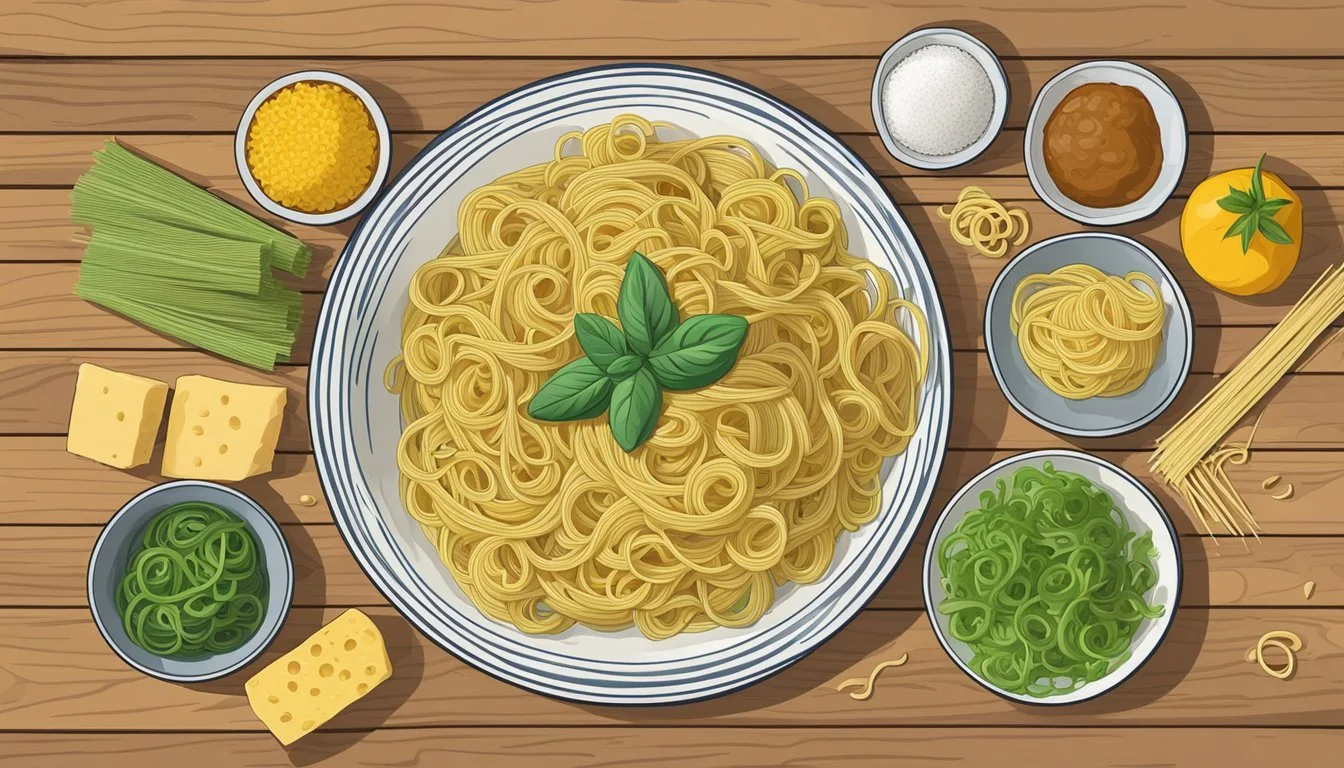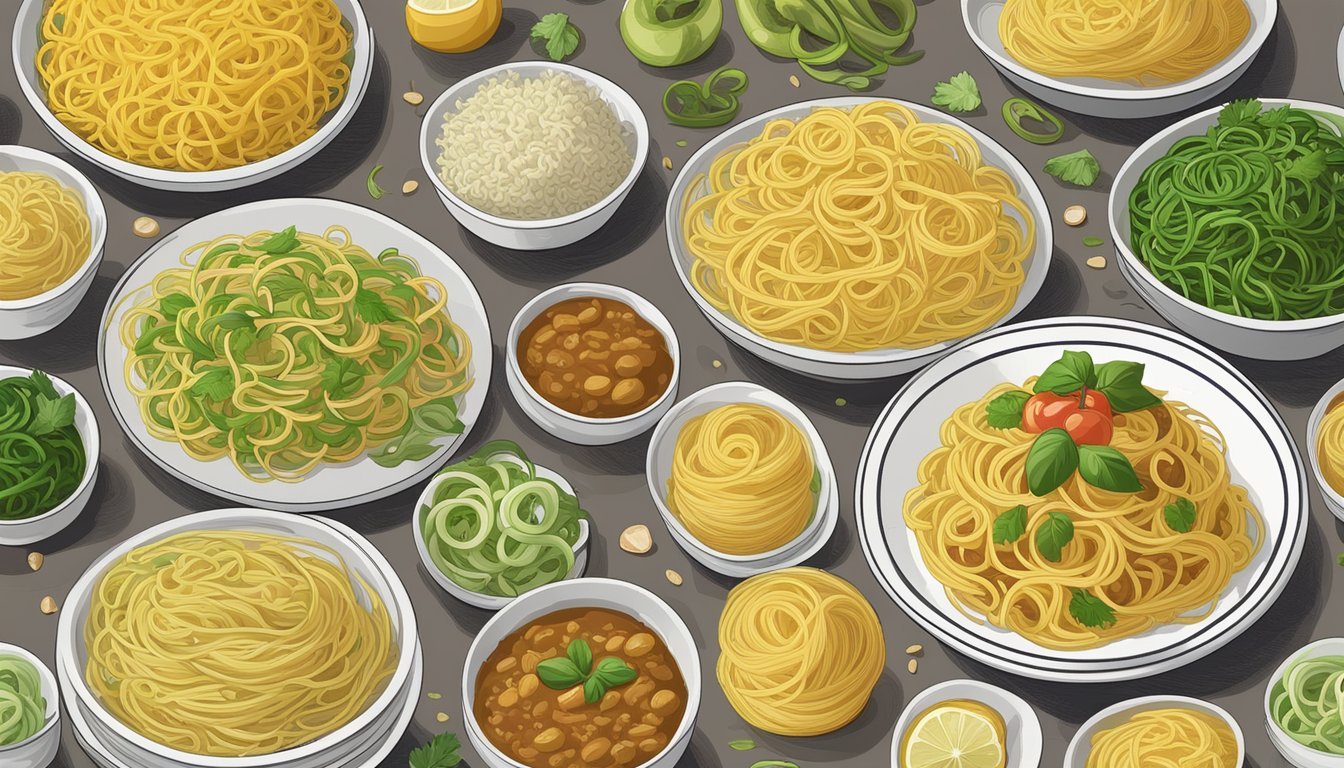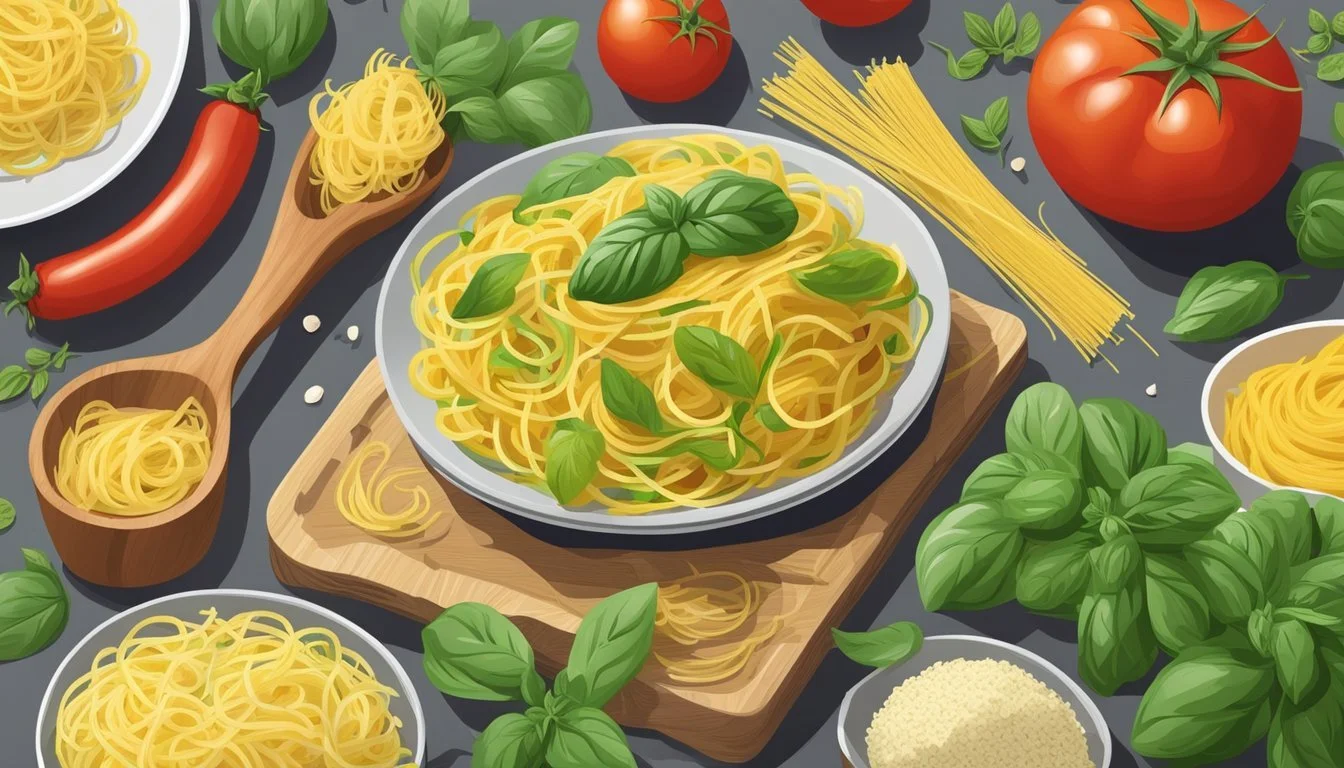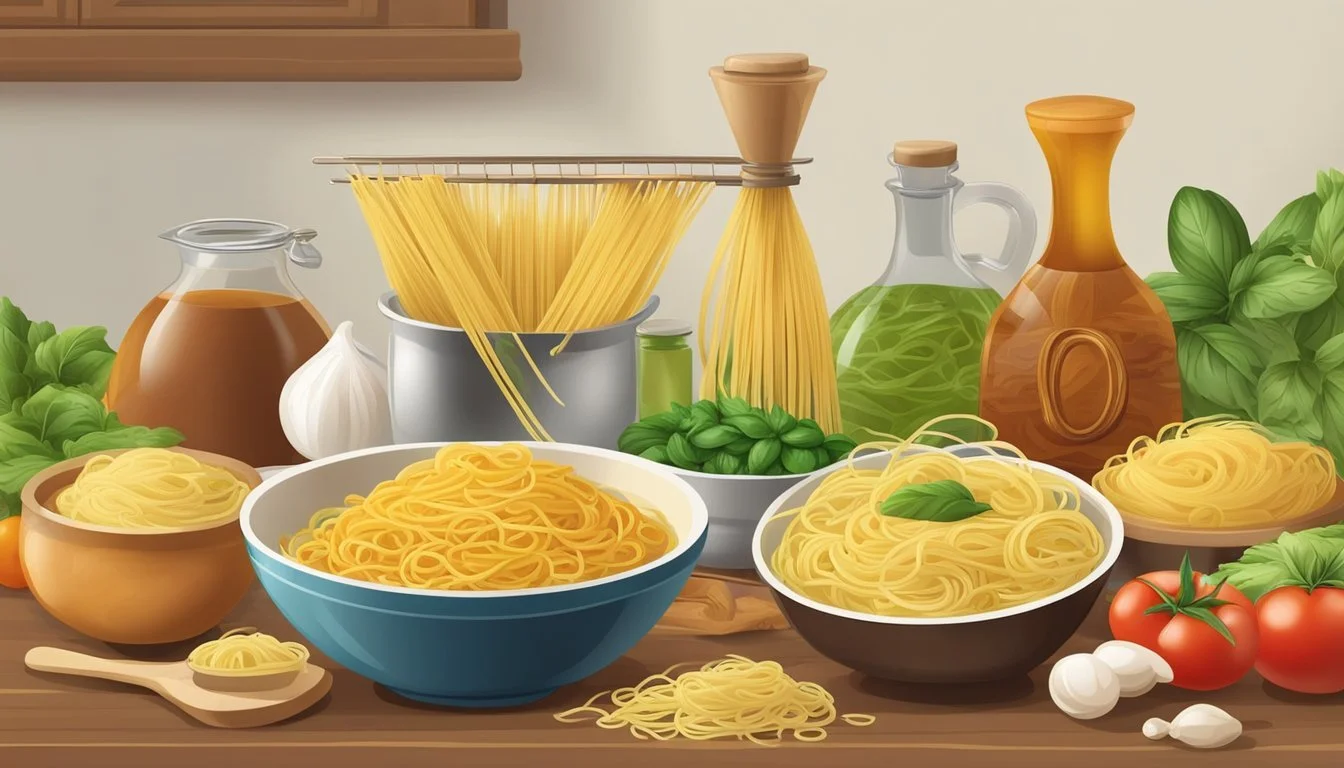Spaghettoni Pasta Substitutes
Top Alternatives for Your Italian Dishes
Spaghettoni pasta (What wine goes well with pasta?), with its thick and long strands, is a favorite for many pasta enthusiasts looking to enjoy a substantial and hearty meal. However, at times one may seek alternatives, either due to dietary restrictions, texture preferences, or simply for a bit of culinary variety. Pasta substitutes come in handy in such situations, providing a range of options that maintain the essence of a pasta dish while offering new flavors and nutritional benefits.
Finding the right substitute for spaghettoni relies on understanding the texture and sauce-pairing qualities of this pasta. Spaghettoni's robust structure makes it ideal for heavier, meat-based sauces, yet it can also complement simpler sauces with its satisfying bite. Pasta substitutes, therefore, need to offer similar characteristics in order to successfully take the place of spaghettoni in a dish.
Options like spaghetti and bucatini provide a closely-matched texture, with the ability to absorb and hold onto sauces well. When considering health-conscious alternatives, whole wheat pasta or legume-based noodles can offer added nutritional value while maintaining a pleasing texture. Each substitute brings its own unique qualities to the table, allowing for versatility and creativity in pasta-based dishes.
Understanding Spaghettoni
Spaghettoni is a distinctive type of pasta that offers a unique texture and ability to pair with robust sauces due to its larger diameter compared to standard spaghetti.
Characteristics of Spaghettoni
Spaghettoni, a traditional Italian pasta, has a thicker diameter usually around 2mm, setting it apart from its more well-known cousin, spaghetti, which typically measures at about 1mm in thickness. The main ingredient in spaghettoni is durum wheat, which gives the pasta its firm texture and ability to hold its shape during cooking.
Texture: Firm and chewy, providing a satisfying mouthfeel.
Diameter: Approximately 2mm, larger than standard spaghetti.
Cooking Time: Adjusted to accommodate its larger diameter, usually taking slightly longer than thinner pasta varieties.
Culinary Uses
In the realm of culinary applications, spaghettoni proves versatile, pairing well with a variety of sauces. Its sturdier shape and texture make it particularly well-suited for heavier sauces.
Heavy Sauces: Ideal for thick, meaty, or creamy sauces that cling to the pasta's substantial surface.
Pasta Shape Influence: The shape of spaghettoni holds flavors well, enhancing the overall flavor profile of the dish.
Suggested Dishes: Works best in dishes where pasta is the focus and is complemented by hearty ingredients.
Nutritional Profile
The nutritional profile of Spaghettoni, as with most pasta, hinges on its carbohydrate content, with a complement of proteins and essential micronutrients. Breaking this down helps to understand the nutritional value Spaghettoni brings to a meal.
Macronutrients in Spaghettoni
Calories: Traditional Spaghettoni pasta, being carbohydrate-dense, has a substantial caloric content. A typical serving may contain around 200 calories.
Carbohydrates: The primary macronutrient in Spaghettoni is carbohydrates, which provide the bulk of the energy in the form of starches. A standard serving can contain approximately 40 grams of carbohydrates.
Protein: Pasta, although not a high-protein food, contributes to daily protein intake. Spaghettoni can offer about 7 grams of protein per serving.
Fiber: Depending on whether it is made from refined or whole wheat flour, the fiber content varies. Whole wheat Spaghettoni pasta contains more fiber, aiding in digestive health.
Fat: It is naturally low in fat, with a serving containing less than 1 gram.
Nutrient Amount per serving Calories ~200 Carbohydrates ~40g Protein ~7g Fiber Variable Fat <1g
Micronutrients and Health Benefits
Vitamins and Minerals: Spaghettoni is a source of several B vitamins, particularly when enriched. It also provides minerals such as iron and magnesium, important for blood health and bone maintenance respectively.
Nutritional Value: The presence of iron helps in the transportation of oxygen in the blood, whereas magnesium plays a vital role in over 300 enzymatic reactions in the human body. Regular consumption of pasta made from whole grains can contribute to daily requirements of these micronutrients.
Health Benefits: Pasta, especially when made from whole grains, offers a lower glycemic index which means it is digested more slowly, providing longer-lasting energy without causing rapid spikes in blood sugar levels. This can help individuals feel fuller for longer periods.
Micronutrient Function B vitamins Energy metabolism and red blood cell formation Iron Oxygen transport Magnesium Enzymatic function and bone health
Common Substitutes
When considering substitutes for spaghettoni pasta, individuals typically seek alternatives that align with specific dietary preferences or culinary requirements. The following options provide a range of choices that cater to health-conscious consumers and those with dietary restrictions while aiming to maintain the textural and flavor qualities that are characteristic of traditional pasta dishes (What wine goes well with pasta dishes?).
Whole Wheat and Multigrain Pastas
Whole wheat and multigrain pastas serve as a robust substitute for spaghettoni, offering added nutritional benefits such as increased fiber and a more complex flavor profile. They come in various shapes, including fettuccine and linguine, which bear textural similarities to spaghettoni and can support a multitude of sauces.
Whole Wheat Fettuccine: A heartier texture with a nutty flavor.
Multigrain Linguine: A mix of grains adds a nutritious twist while maintaining pasta integrity.
Gluten-Free Alternatives
For those looking to avoid gluten, a variety of gluten-free pasta options are available that closely replicate the experience of traditional pasta. Staples include rice, corn, or quinoa (What wine goes well with quinoa?) -based pastas, and alternatives such as those made from chickpeas or lentils. These substitutes hold their shape well and provide a satisfying al dente bite.
Rice-Based Spaghetti: A classic gluten-free option, pairing well with many sauces.
Quinoa-Based Linguine: High in protein and has a similar mouthfeel to regular pasta.
Vegetable-Based Options
The trend toward vegetable-based pasta alternatives caters to those aiming for lower-carb or more nutrient-dense meals. Vegetables such as zucchini, butternut squash, and spaghetti squash can be spiralized to mimic the shape of spaghettoni, offering a fresh and light option encapturing a subtle sweetness to dishes.
Zucchini Noodles (Zoodles): Light with a slight crunch; pair with pesto or light sauces.
Butternut Squash: A sweeter option that can complement hearty, savory sauces.
Spaghetti Squash: When cooked, the flesh separates into strings resembling spaghetti, a perfect bed for various pasta sauces.
Substitute Considerations
When choosing a substitute for Spaghettoni pasta, it's important to find options that closely mimic its characteristics to maintain the integrity of the dish it's used in.
Matching Flavors and Textures
The unique texture of Spaghettoni pasta is robust and slightly chewy, making it a pleasure to eat in a variety of dishes. Ideal substitutes are those with similar thickness and chew, ensuring that the eating experience remains consistent. Fettuccine can serve as a good substitute due to its flat and thick structure, providing a comparable mouthfeel. Moreover, Spaghetti is a readily available alternative that represents a more common form with a suitable texture and diameter.
Best Textural Matches:
Fettuccine
Spaghetti
Sauce Pairing
Spaghettoni's sturdy nature makes it suitable for hearty sauces, such as bolognese, carbonara, or creamy sauces. The substitute should similarly possess the ability to hold onto these rich and dense sauces effectively. Spaghetti can do justice to tomato-based marinara or olive oil-based pesto sauce due to its comparable surface area. For heavier, meat-based sauces, Fettuccine’s broader ribbons are excellent at sopping up the sauce, making every bite flavor-packed.
Pairings for Common Sauces:
Pesto & Marinara: Spaghetti
Bolognese & Creamy Sauces: Fettuccine
Nutritional Adaptations
Substituting Spaghettoni with alternatives that offer different nutritional profiles can cater to dietary needs or preferences. For those looking for a gluten-free option, brown rice pasta preserves a firm texture and can impart a slight nutty flavor, complementing both light and robust sauces. Its shape and size can accommodate the full range of sauces from light olive oil-based dressings to richer creamy concoctions. Additionally, wholesome grain pastas like quinoa varieties provide a protein boost and are suitable for hearty dishes such as bolognese or carbonara, as well as lighter salads.
Nutrition-Focused Substitutes:
Brown Rice Pasta: Gluten-Free, Nutty Flavor
Quinoa Pasta: High-Protein, Versatile Use
Special Diets and Allergens
When it comes to Spaghettoni pasta substitutes, consumers with dietary restrictions or allergies have a variety of options. These alternatives cater to low-carbohydrate and gluten-free diets, and include plant-based varieties for vegetarians and vegans.
Low-Carbohydrate and Keto Options
For individuals following a low-carb or ketogenic diet, traditional pasta is typically off the table due to its high carbohydrate content. Fortunately, there are several suitable substitutes:
Butternut Squash Spirals: With only 12 grams of carbs per cup, butternut squash spirals are a nutritious option rich in vitamins A, C, and E.
Zucchini Noodles (Zoodles): These spirals are a staple for low-carb dieters and can be prepared quickly in 1 to 2 minutes.
Cabbage Noodles: Cabbage can be sliced thinly to create noodles with about 6 grams of carbs per 100 grams.
Substituting grains like rice noodles or quinoa-based pastas can be lower in carbs than traditional pasta, but these options may still be too high in carbohydrates for strict keto dieters.
Vegetarian and Vegan Varieties
Substitutes for pasta that satisfy vegetarian and vegan requirements focus on avoiding animal products while providing the experience and nutrition one seeks from pasta.
Legume-based Pastas (e.g., Chickpea Penne): These are not only gluten-free but come packed with protein and fiber, suitable for vegetarians and vegans.
Soba Noodles: Made from buckwheat, soba noodles are a gluten-free option that is ideal for those avoiding wheat and grains.
For each of these substitutes, checking the label for additional ingredients that may conflict with allergens or dietary restrictions is advisable.
Creative Culinary Uses
Spaghettoni pasta, known for its thickness and chewy texture, brings robustness to dishes that thinner noodles cannot. This section explores inventive ways to utilize spaghettoni in the kitchen, from harmonious pairings to ventures into non-traditional pasta dishes.
Innovative Recipes and Pairings
The sturdiness of spaghettoni makes it an ideal contender for holding up to hearty sauces and robust ingredients. In recipe development, one might consider the following pairings:
Garlic and Olive Oil: Simple yet flavorful, tossing spaghettoni with garlic sautéed in high-quality olive oil creates an aromatic base that’s versatile and satisfying.
Seafood Symphony: They can create a delightful seafood pasta featuring spaghettoni with shrimp, tossed in a light sauce of olive oil, garlic, and a touch of lemon zest.
Cheese and Pepper: A Cacio e Pepe-style dish using spaghettoni provides a comforting meal where the thick noodles carry the creamy mixture of butter, Parmesan cheese, and a generous seasoning of black pepper.
For those seeking to infuse an Italian pasta twist to their meals, incorporating spaghettoni with chicken in a pesto sauce or combining it with meatballs in a classic marinara showcases how spaghettoni can be a centerpiece in traditional and modern recipes.
Dishes Beyond Traditional Pasta
Spaghettoni's versatility extends beyond the plate of pasta with marinara. They are crafting novel dishes with these thick noodles can include:
Asian Fusion: Substitute spaghettoni in place of traditional Asian noodles for a new twist on stir-fry or noodle salads, garnished with sesame seeds and green onions.
Baked Gratins: They can layer spaghettoni, rich béchamel sauce, and a mixture of cheeses to create a luxurious baked pasta gratin that will have a crispy top and creamy interior.
Each noodle's texture offers a unique experience in every bite. Cooking spaghettoni al dente ensures that it retains its renowned texture throughout these creative culinary applications.
Cooking and Preparation Tips
When preparing spaghettoni, the critical factors for excellent results are the cooking time and technique. Perfectly cooked spaghettoni should be al dente, with the right balance of chewiness and tenderness, enhanced with flavorful additions of fats and herbs to complement its robust texture.
Achieving the Perfect 'Al Dente'
For authentic spaghettoni, the ideal texture is 'al dente', which means the pasta is cooked to be firm to the bite.
Cooking Time: Start with boiling a large pot of salted water. Once the water is at a rolling boil, add the spaghettoni and stir occasionally to prevent sticking. Typical cooking times for spaghettoni range from 10 to 14 minutes, but it's best to start testing for doneness around the 10-minute mark. Remember that the pasta will continue to cook slightly after it's been removed from the water.
Testing for Doneness: Take out a strand of spaghettoni, let it cool, and then taste it. It should be tender but still have a slight resistance in the center. If it's too firm, continue cooking for another minute and test again.
Substitute Cooking Techniques
While the traditional method involves boiling spaghettoni, various cooking techniques can yield similar results for substitutes when spaghettoni is unavailable.
Steaming: Works well with substitutes like spinach pasta, allowing it to retain its color and nutrients without overcooking.
Sautéing: After boiling, tossing the pasta in a pan with a bit of olive oil or butter can enhance the flavors. For substitutes like zucchini noodles, sautéing is the primary cooking method.
Enhancing Flavor: Consider incorporating a squeeze of lemon or a sprinkle of fresh herbs during the final stages of preparation to freshen and uplift the substitute pasta dish.
Remember, while substitutes may require adjustments in cooking time or method, achieving 'al dente' texture remains the goal to strive for similar satisfaction in the dish.
Exploring Cultural Variations
In the realm of pasta, cultural influences have brought forth a diverse tapestry of shapes and preparations, reflecting regional tastes and culinary traditions across the globe.
Pasta in Italian Cuisine
Italian cuisine exhibits pride in its pasta variations, many of which are deeply embedded in regional tradition. Spaghettoni, a thicker cousin to spaghetti, is revered for its chewier texture. In Italy, it's not uncommon to find regional festivals, or "sagre," celebrating such unique pasta shapes. For substituting this type, key alternatives include:
Capellini (angel hair): A very thin variant of spaghetti.
Spaghettini: Slightly thicker than angel hair but thinner than spaghettoni.
Tagliatelle: A flat pasta that can mimic spaghettoni’s texture in sauces.
Vermicelli: Though thinner than spaghettoni, it holds up well in a variety of dishes.
Each region in Italy may offer a distinct take on pasta dishes, often resulting in small but significant differences in both texture and sauce pairings, highlighting the versatility and regional pride within Italian cuisine.
Global Pasta Interpretations
Globally, pasta embraces a multitude of shapes and culinary contexts surpassing Italian borders. Asian versions of pasta, for instance, equate to a range of noodles integral to various dishes across the continent. From thin, delicate strands akin to Italian capellini, to broader, flatter shapes resembling tagliatelle, the variety is extensive. In American cuisine, macaroni and cheese has become a comfort food staple, often incorporating tubular shapes like macaroni which diverge from Italian traditions. The constant interplay of culinary innovation and tradition across different cultures has expanded the global pasta repertoire significantly, with various regions creating their own specialized pasta experiences that offer substitutions and alternatives to traditional Italian offerings.







